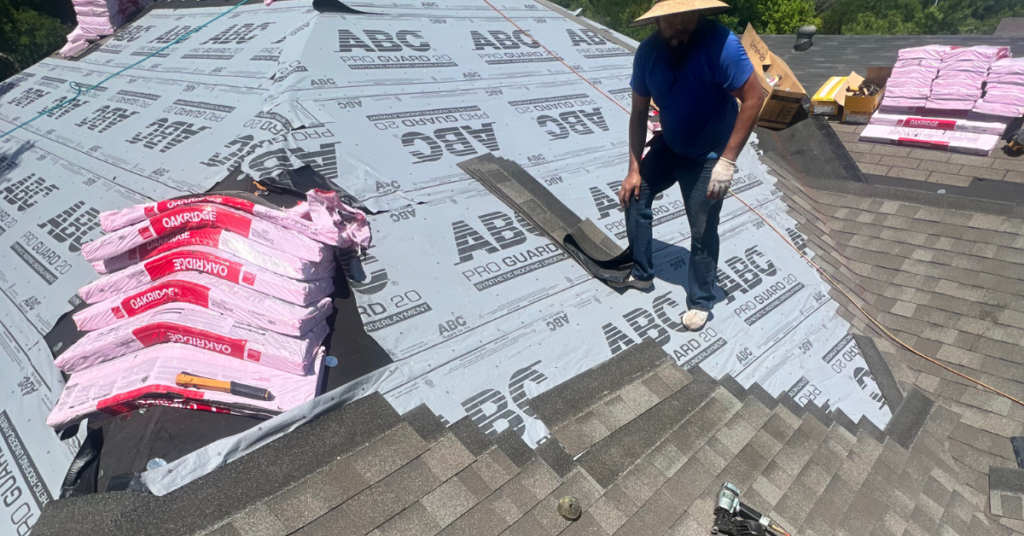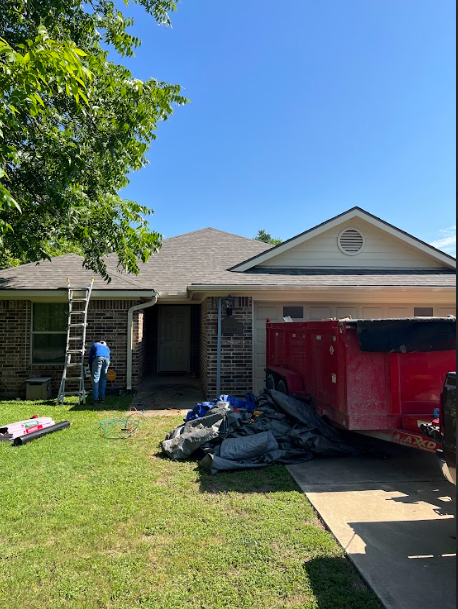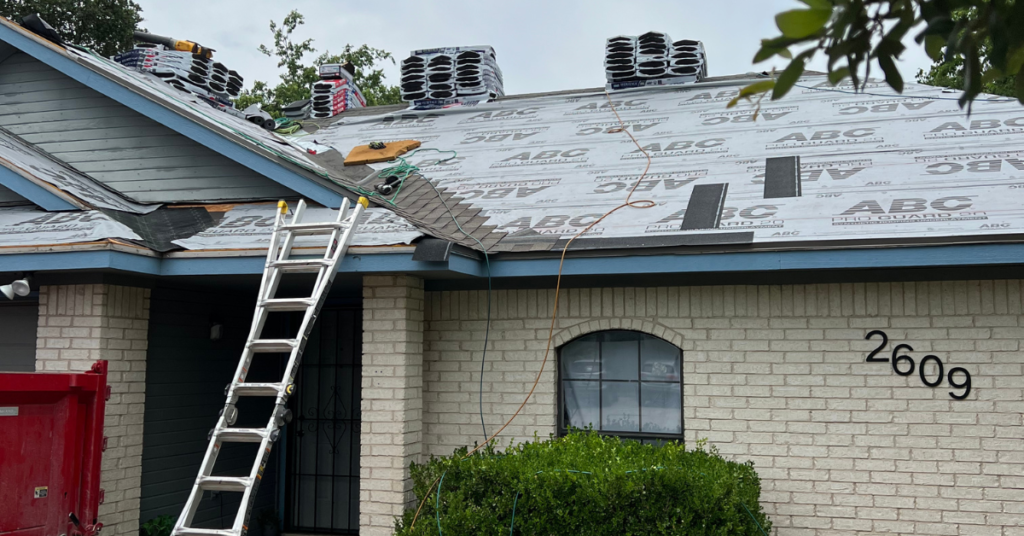Which roofing style will best withstand the diverse weather conditions in Texas? The decision-making process for choosing the right roofing style for your home can be overwhelming, but it doesn’t have to be.
From the traditional asphalt shingle roof to the more unconventional flat roofing options, each style has its advantages and drawbacks. As you consider the best fit for your Texas home, understanding the specific pros and cons of each roofing style will be crucial in ensuring that your investment stands the test of time.

Key Takeaways
- ire more frequent repairs and replacements, increasing the total cost of ownership.
- Metal roofing is highly durable and energy-efficient, with a lifespan of 40-70 years. It is also environmentally friendly as it is made from recycled materials and is fully recyclable.
- Tile roofing offers excellent durability and thermal insulation properties, reducing energy costs. However, it has higher installation and maintenance costs compared to other materials.
- Wood shake roofing provides a classic and natural aesthetic appeal, but it is less fire-resistant and requires regular inspections and cleaning for longevity.
- Flat roofing is a cost-effective option with a contemporary aesthetic appeal and additional interior space. However, it is prone to water pooling and debris accumulation, requiring proper drainage and regular inspections.
Asphalt Shingle Roofing
If you’re considering asphalt shingle roofing for your home in Fort Worth, TX, Secured Roofing can provide you with professional installation and repair services. Asphalt shingle roofing is a popular choice for many homeowners due to its cost-effectiveness and ease of installation. One of the main advantages of asphalt shingle roofing is its affordability compared to other roofing styles. It’s one of the most cost-effective options, making it a practical choice for homeowners on a budget. Additionally, asphalt shingle roofing comes in a variety of colors and styles, allowing you to customize the look of your home.
However, there are some disadvantages to consider as well. While asphalt shingle roofing is affordable, it may not last as long as other roofing materials such as metal or tile. Asphalt shingles typically have a lifespan of 15-30 years, whereas metal and tile roofs can last 50 years or more. It’s important to weigh the initial cost savings against the long-term durability when making your decision.
When comparing the cost of different roofing styles, it’s important to consider not only the initial installation cost but also the long-term maintenance and replacement expenses. While asphalt shingle roofing may have a lower upfront cost, it could require more frequent repairs and replacements compared to other materials. It’s essential to consult with a professional roofing contractor like Secured Roofing to assess the total cost of ownership for each roofing style before making a decision.
Metal Roofing
Considering the durability and long-term value of roofing materials, metal roofing emerges as a compelling option for homeowners in Fort Worth, TX, seeking a resilient and low-maintenance roofing solution.
- Cost Effectiveness and Durability of Metal Roofing: Metal roofing is highly durable, with a lifespan of 40-70 years, significantly outlasting traditional asphalt shingles. This longevity translates to cost savings in the long run, as metal roofs require minimal maintenance and are less prone to damage from weather elements like hail and wind. The initial investment in metal roofing may be higher than some other options, but the extended lifespan and reduced maintenance costs make it a cost-effective choice over time.
- Energy Efficiency and Environmental Benefits of Metal Roofing: Metal roofs are highly reflective, effectively reducing the amount of heat absorbed into the home. This reflective property lowers cooling costs, particularly during the hot Texas summers, making it an energy-efficient option. Additionally, metal roofing is often made from recycled materials and is fully recyclable at the end of its long lifespan, making it an environmentally friendly choice for homeowners looking to reduce their carbon footprint.
When considering metal roofing for your home in Fort Worth, TX, you can be confident in its ability to provide long-term value, energy efficiency, and environmental benefits, making it a wise investment in the protection and sustainability of your property.
Tile Roofing
When selecting a roofing material for your home in Fort Worth, TX, tile roofing presents an elegant and durable option with a rich history of performance and aesthetic appeal. The benefits of tile roofing for Texas homes are numerous.
Firstly, it’s highly durable and can withstand harsh weather conditions, making it particularly suitable for the Texas climate. Additionally, tile roofing has excellent thermal insulation properties, helping to keep your home cool in the hot Texas summers and reducing energy costs. Moreover, it offers a wide range of colors and styles, allowing you to customize the look of your home to your preference.
However, before choosing tile roofing, there are important factors to consider. The weight of tile roofing is considerable, so it’s crucial to ensure that your home’s structure can support it. Additionally, installation and maintenance costs for tile roofing can be higher compared to other roofing materials, so it’s essential to factor in the long-term investment. Moreover, while tile roofing is known for its durability, individual tiles can crack or break, requiring periodic inspection and maintenance.
Wood Shake Roofing
Wood shake roofing offers a timeless and rustic aesthetic for Texas homes. It provides a durable and natural option for homeowners seeking a distinctive look and reliable protection.
Here are the pros and cons of wood shake roofing, as well as how it compares to other roofing styles:
Pros of Wood Shake Roofing
- Aesthetic Appeal: Wood shake roofing provides a classic, natural look that complements many architectural styles, adding warmth and character to your home.
- Durability: When properly installed and maintained, wood shake roofs can have a lifespan of 30 years or more, making them a long-term investment in your home’s protection.
Cons of Wood Shake Roofing
- Maintenance: Wood shake roofs require regular maintenance, including inspections for mold, mildew, and insect infestations, as well as periodic cleaning and resealing to ensure longevity.
- Fire Resistance: Wood shake roofing is less fire-resistant compared to other roofing materials, which may be a concern in areas prone to wildfires.
When comparing wood shake roofing to other styles, it’s essential to consider the unique characteristics of each option. For instance, while wood shake roofs offer a natural and timeless appeal, they may require more maintenance compared to metal or asphalt shingle roofing. Additionally, the fire resistance of wood shake roofing differs significantly from that of concrete tiles or metal roofs.
Understanding these differences can help you make an informed decision based on your specific needs and preferences.
Flat Roofing
Flat roofing provides a sleek and modern design option for Texas homeowners seeking a low-maintenance and space-efficient roofing solution. One of the key advantages of flat roofs is their cost-effectiveness. The construction of a flat roof typically requires fewer materials and less labor compared to other roofing styles, making it a more budget-friendly option. Additionally, the flat surface of the roof can be utilized for various purposes such as installing solar panels, creating an outdoor living space, or setting up a rooftop garden, adding value to your property and enhancing its functionality.
However, there are some disadvantages to consider. Flat roofs are more prone to water pooling, which can lead to water damage if not addressed promptly. Proper drainage systems and regular inspections are essential for preventing this issue. Moreover, the lack of slope on a flat roof can result in debris accumulation, requiring frequent cleaning and maintenance to prevent clogging and potential structural damage.
In terms of aesthetic appeal, flat roofs offer a contemporary and minimalist look that can complement modern architectural designs. They also provide additional interior space, allowing for potential expansion or the installation of HVAC units and other equipment. However, it’s important to note that the lack of slope may lead to reduced water runoff, potentially causing leaks if not properly sealed and maintained.
When considering flat roofing for your Texas home, weigh these pros and cons to determine if it aligns with your desired combination of functionality, aesthetics, and maintenance requirements.

Frequently Asked Questions
What Are the Specific Maintenance Requirements for Each Type of Roofing Style in the Texas Climate?
When considering maintenance requirements and climate adaptation for different roofing styles in Texas, it’s crucial to factor in the unique weather conditions. Regular inspection and upkeep are essential for all roofing types, but metal roofs may require less maintenance due to their durability. Additionally, asphalt shingles are popular for their cost-effectiveness and aesthetic appeal, but they may need more frequent maintenance in the Texas climate. Consider these factors when choosing a roofing style.
Are There Any Restrictions or Regulations in Fort Worth, TX Regarding the Use of Certain Roofing Materials, Such as Wood Shake or Tile?
When it comes to roofing materials in Fort Worth, TX, it’s important to be aware of the regulations and restrictions. Certain materials like wood shake or tile may have specific requirements due to their composition and potential impact on the surrounding environment. Before making a decision, it’s crucial to understand the maintenance requirements and how each material performs in the Texas climate. Stay informed to ensure your roofing choice complies with local regulations.
How Do the Different Roofing Styles Affect Energy Efficiency and Insulation in Texas Homes?
When considering roofing styles, it’s important to assess how they impact energy efficiency and insulation in Texas homes. Material comparison and cost analysis are crucial in making an informed decision. Factors like reflectivity, thermal mass, and insulation properties vary between roofing materials, affecting energy consumption and indoor comfort. Understanding these aspects will help you choose a roofing style that maximizes energy efficiency and provides optimal insulation for your Texas home.
Are There Any Specific Considerations for Choosing a Roofing Style in Texas to Withstand Severe Weather Conditions, Such as High Winds or Hail?
When choosing a roofing style in Texas, it’s crucial to consider materials with high wind resistance and hail protection. Look for durable options like metal or asphalt shingles. Metal roofs excel in wind resistance, while impact-resistant shingles provide reliable hail protection. Understanding the specific risks in your area will help you make an informed decision. Prioritize durability and resilience to ensure your home is well-equipped to withstand severe weather conditions.
What Are the Long-Term Durability and Lifespan Differences Between the Various Roofing Styles in the Texas Climate?
When comparing roofing styles for Texas, consider the longevity and weather resistance. Metal roofs offer exceptional durability, lasting 50+ years, and withstand high winds. Asphalt shingles are common but have a shorter lifespan of 20-30 years. Tile roofs provide longevity, around 50 years, and are resilient to weather. For Texas’ climate, metal and tile roofs offer superior durability, while asphalt shingles are more affordable but require more frequent replacement.
When it comes to choosing the best roofing style for your Texas home, consider the climate, durability, and aesthetic appeal of each option. While asphalt shingle roofing offers affordability and easy installation, metal roofing provides excellent durability and energy efficiency. Tile roofing adds a touch of elegance but may be more prone to damage from hail. Woodshake Roofing offers a unique look but requires regular maintenance. Flat roofing is suitable for modern architectural designs but may require additional waterproofing. Choose wisely based on your specific needs and preferences.

